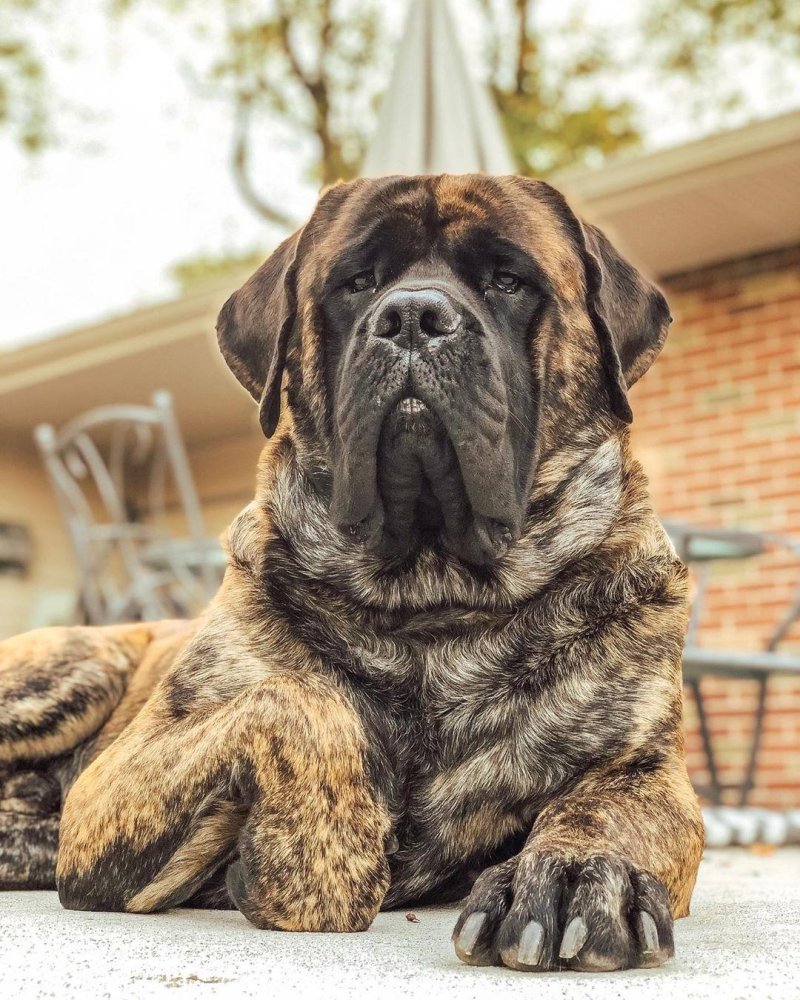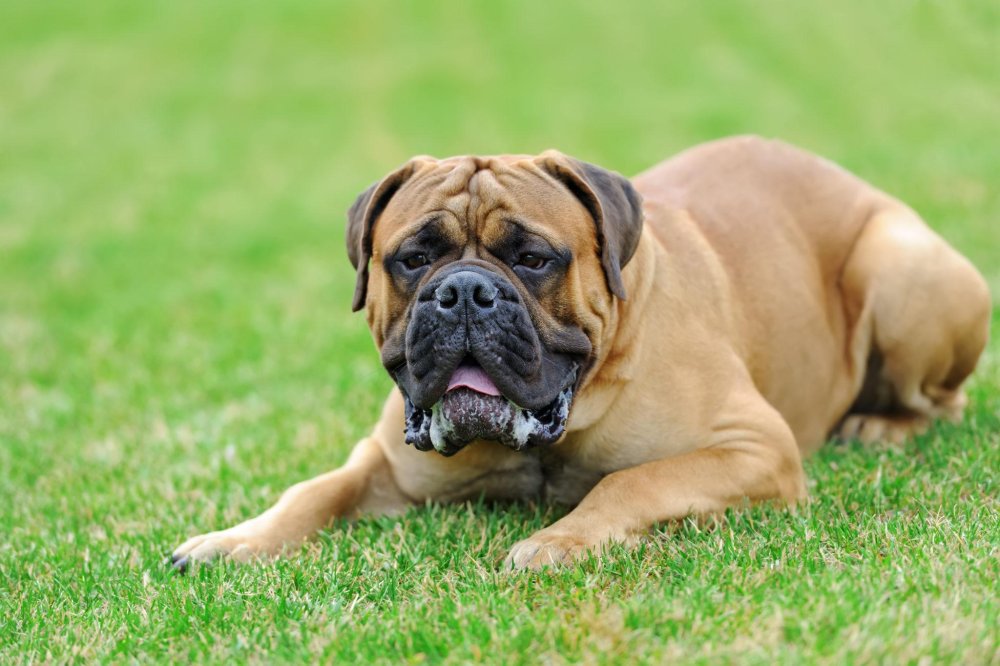- Breed Category: Working Group
- Country of Origin: England
- Average Height: Males 76 cm (30 in), Females 70 cm (27.5 in)
- Average Weight: Males 72-104 kg (160-230 lbs), Females 54-77 kg (120-170 lbs)
- Average Life Span: 6-10 years
- Grooming Requirements: Low, occasional brushing
- Exercise Requirements: Moderate, daily walks
- Coat Type: Short and dense
- Coat Color Variations: Fawn, apricot, brindle
- Shedding Level: Moderate
- Ear Type: Drop ears
- Tail Type: Long and tapering
- Temperament: Gentle, protective, loyal
- Intelligence Level: Moderate
- Barking Tendency: Low
- Compatibility with Children: High, very good with kids
- Compatibility with Other Pets: Generally good with supervision
- Training Ease: Moderate, requires patience
- Common Health Issues: Hip dysplasia, bloat, heart issues
- Dietary Needs: High-quality, large-breed diet
- Energy Level: Low to moderate
- Drooling Tendency: High
- Sensitivity to Weather: Sensitive to heat
- Overall Maintenance Level: Moderate
- Original Purpose: Guarding and protection
- Year of Recognition by Kennel Clubs: 1885
- Apartment Friendly: Yes, with sufficient exercise
- Best Suited For: Families, experienced dog owners
- Cost of Ownership: High, due to size and health
- Unique Traits: Massive size, gentle giant
- Cultural Significance: Featured in historical art and literature
- Popularity Rank: Moderate
Think all big dogs are the same? Let’s dive into the world of the English Mastiff and see what sets them apart. Known for their massive size and gentle nature, these dogs are a fascinating blend of history and character. This article aims to give you a clear picture of what makes the English Mastiff unique, from their ancient origins to their modern-day care needs.
The English Mastiff has a storied past, tracing back to ancient times. They were once used as war dogs and protectors, admired for their strength and loyalty. Over the centuries, they’ve evolved into the gentle giants we know today, beloved for their calm and affectionate temperament. Understanding their history helps us appreciate their unique characteristics and needs.
Early Development and Historical Significance of the English Mastiff

Early Development of the Breed
The English Mastiff’s roots run deep, with origins that can be traced back to ancient civilisations. These dogs were initially bred for their formidable size and strength, making them ideal for guarding and protection roles. Over time, selective breeding refined their temperament, transforming them from fierce protectors to the gentle giants we cherish today.
Role in Historical Contexts and Uses
Throughout history, English Mastiffs have played significant roles, from being war dogs in Roman times to estate guardians in medieval England. Their imposing presence and unwavering loyalty made them invaluable in various settings, whether on the battlefield or at home.
Key Historical Figures and Events
One notable figure in the breed’s development was Sir Peers Legh, whose Mastiff protected him during the Battle of Agincourt in 1415. This event highlighted the breed’s bravery and loyalty, cementing its reputation as a steadfast companion.
Physical Characteristics
English Mastiffs are known for their massive build, with males often weighing over 100 kilograms. Their broad head, deep chest, and muscular frame give them a commanding presence. Despite their size, they are surprisingly agile and possess a gentle, expressive face that reflects their calm nature.
Appearance and Unique Traits of the English Mastiff

Appearance
When you first lay eyes on an English Mastiff, their sheer size is hard to miss. These dogs are truly massive, with males often tipping the scales at over 100 kilograms. Their coat is short and comes in a variety of colours, including fawn, apricot, and brindle, often with a distinctive black mask that adds to their dignified look. Their broad head and deep-set eyes give them a wise, almost regal expression.
Unique Physical Traits
Beyond their size, English Mastiffs have a few unique physical traits that set them apart. Their massive build is complemented by a muscular frame and a deep chest, which not only gives them strength but also a surprisingly agile presence. Despite their imposing stature, their gentle expression often surprises those who meet them for the first time.
Temperament and Behaviour
English Mastiffs are known for their calm and gentle temperament. They are incredibly loyal and form strong bonds with their families. While they may appear intimidating, they are generally good-natured and patient, making them excellent companions. Their protective instincts are strong, but they are not aggressive by nature, preferring to observe and assess situations before reacting.
Personality Traits and Suitability as a Family Pet

Typical Personality Traits
English Mastiffs are the epitome of gentleness and loyalty. Their protective nature is well-known, making them excellent guardians without the need for aggression. They are calm and composed, often preferring to observe rather than react impulsively. This makes them reliable companions who are deeply devoted to their families.
Suitability as a Family Pet and Guard Dog
These gentle giants are perfect for families. Their size might be intimidating, but their hearts are full of affection. They are naturally protective, ensuring your home is safe while being loving companions. Their loyalty is unmatched, and they thrive in environments where they can be part of the family.
Interaction with Children and Other Animals
English Mastiffs are known for their patience with children. They are gentle and tolerant, making them great playmates for kids. With other animals, they are generally calm and non-confrontational, though early socialisation is key to ensuring harmonious interactions.
Training and Exercise Needs
Training an English Mastiff requires patience and consistency. They respond well to positive reinforcement and gentle guidance. While they don’t need excessive exercise, regular walks and playtime are essential to keep them healthy and happy. Their size means they need space, but they are surprisingly adaptable to different living situations.
Training, Exercise, and Health of the English Mastiff

Importance of Early Training and Socialisation
Getting your English Mastiff started with training and socialisation early on is crucial. These gentle giants need to learn how to interact with people and other animals to ensure they grow into well-mannered adults. Early exposure to different environments, sounds, and experiences helps them become confident and adaptable.
Recommended Training Techniques
When it comes to training, patience and consistency are key. English Mastiffs respond best to positive reinforcement methods. Use treats, praise, and gentle encouragement to guide them. Avoid harsh corrections, as these can be counterproductive with their sensitive nature.
Daily Exercise Requirements and Activities They Enjoy
Despite their size, English Mastiffs don’t require excessive exercise. A couple of daily walks and some playtime in the yard usually suffice. They enjoy leisurely strolls and interactive games that engage their minds. Remember, their joints need care, so avoid high-impact activities.
Health and Lifespan
English Mastiffs are generally healthy, but like all breeds, they’re prone to certain conditions. Regular vet check-ups and a balanced diet are essential. They typically live between 6 to 10 years. Keeping them at a healthy weight and providing joint support can enhance their quality of life.
Health and Care of the English Mastiff

Common Health Issues
English Mastiffs, like many large breeds, can face specific health challenges. Hip and elbow dysplasia are common, as are heart conditions and bloat. Regular vet visits are crucial to catch any issues early. Keeping an eye on their weight can also help prevent joint problems.
Average Lifespan and Health Tips
These gentle giants typically live between 6 to 10 years. To keep them healthy, focus on a balanced diet and regular exercise. Joint supplements can be beneficial, especially as they age. Ensuring they have a comfortable place to rest is also important for their well-being.
Preventative Care Recommendations
Preventative care is key for English Mastiffs. Regular vaccinations, flea and tick prevention, and dental care should be part of their routine. Regular grooming helps keep their coat healthy and allows you to check for any skin issues or parasites.
Grooming and Maintenance
Despite their size, English Mastiffs are relatively low-maintenance when it comes to grooming. Their short coat requires weekly brushing to remove loose hair and keep it looking its best. Regular nail trims and ear checks are also important to prevent infections.
Coat Care and Grooming Routines for English Mastiffs

Coat Care and Grooming Routines
English Mastiffs have a short, dense coat that’s relatively easy to maintain. A weekly brush with a rubber grooming mitt or a bristle brush will help keep their coat healthy and shiny. This routine not only removes loose hair but also distributes natural oils, keeping their skin in good condition. Regular grooming sessions are a great opportunity to check for any skin issues or parasites.
Shedding and Seasonal Grooming Tips
While English Mastiffs are not heavy shedders, they do experience seasonal shedding, particularly in spring and autumn. During these times, you might need to increase brushing to a few times a week to manage the extra hair. A de-shedding tool can be handy to remove the undercoat efficiently.
Diet and Nutrition
A balanced diet is crucial for the health and longevity of an English Mastiff. High-quality dog food that’s rich in protein and low in fillers is ideal. Given their size, portion control is important to prevent obesity, which can lead to joint issues. Supplements like glucosamine can support joint health, especially as they age. Always ensure they have access to fresh water, and consult your vet for specific dietary needs.
Nutritional Needs and Feeding Guidelines for English Mastiffs

Nutritional Needs for Optimal Health
English Mastiffs need a diet rich in high-quality protein to support their massive muscles. Look for dog food with real meat as the first ingredient. Omega-3 and omega-6 fatty acids are also important for maintaining a healthy coat and skin. Avoid foods with excessive fillers like corn and soy, as these can lead to weight gain and digestive issues.
Foods to Include and Avoid
Include lean meats, fish, and vegetables in their diet. Foods rich in glucosamine and chondroitin can help support joint health. Avoid giving them table scraps, especially those high in fat or containing bones, as these can cause digestive problems.
Feeding Schedules and Portion Recommendations
Feed your English Mastiff twice a day to prevent bloat, a common issue in large breeds. Portion sizes will depend on their age, weight, and activity level, so consult your vet for specific recommendations. Always measure their food to avoid overfeeding.
Fun Facts and Trivia
Did you know that the English Mastiff holds the record for the heaviest dog ever recorded? A Mastiff named Zorba weighed in at a whopping 155.6 kilograms! Despite their size, these gentle giants are known for their calm and affectionate nature, making them wonderful family pets.
Interesting Tidbits and Famous English Mastiffs
Interesting Tidbits about the Breed
English Mastiffs are not just known for their size; they have some pretty interesting quirks too. For instance, they are often referred to as “gentle giants” due to their calm demeanour despite their intimidating appearance. These dogs are also known for their drool, so if you’re considering one, be prepared for a bit of slobber! Another fun fact is that they have a surprisingly low bark frequency, which means they won’t be the loudest dog in the neighbourhood.
Famous English Mastiffs in Media or History
English Mastiffs have made their mark in history and media. One of the most famous Mastiffs was “Hercules,” who appeared in the movie “The Sandlot.” In history, a Mastiff named “Zorba” holds the record for the heaviest dog ever, weighing in at an astonishing 155.6 kilograms. These dogs have also been depicted in various artworks and literature, often symbolising strength and loyalty.
Final Thoughts

The English Mastiff is a gentle giant with a storied past. Their blend of strength and loyalty makes them exceptional companions. While they require careful attention to health and training, their affectionate nature and protective instincts offer immense rewards. Embracing an English Mastiff means welcoming a devoted family member who enriches your life with love and security. Consider adopting one of these majestic dogs and experience the unique bond they offer.
